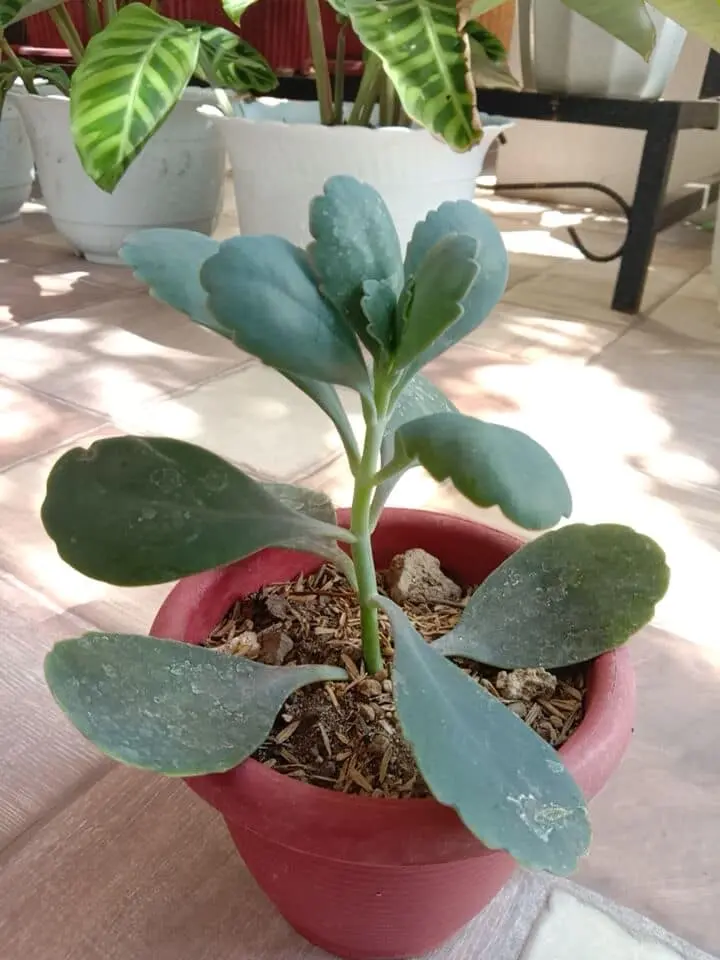Does Kalanchoe Need Direct Sunlight? Answer May Surprise You!
Kalanchoe is a dazzling succulent that can be easily grown indoors if you know its light conditions. One common question that arises among kalanchoe plant owners is whether Kalanchoe plants need direct sunlight to thrive.
Kalanchoe plants do need bright, indirect sunlight but can tolerate some direct sunlight. To ensure optimal growth and health, it’s best to place Kalanchoe plants in a location that receives bright, indirect sunlight for most of the day and some direct sunlight in the morning or late afternoon. Avoid placing Kalanchoe plants in full sun, as this can cause the leaves to burn and the plant to wilt.
Does Kalanchoe Need Direct Sunlight?
Kalanchoe is a succulent that is native to tropical climates. It is easy to care for and requires minimal maintenance, but the question is, does it need direct sunlight?
The answer to this question is generally yes, but it depends. If you want your kalanchoe plant to grow, then YES (it will require direct sunlight). However, if you want to repot your plant without losing its leaves or dying in the process, then NO.
Kalanchoe plants grow well in various light conditions, including bright and indirect light, or even in rooms with artificial light. Find a location for your Kalanchoe that provides adequate light without exposure to direct sunlight for more than 3-4 hours a day.
Kalanchoe loves bright but diffused sunlight. At the same time, unlike other indoor flowers, it prefers short daylight hours (no more than 10-12 hours) and does not need additional illumination in winter.
In summer, it is recommended to place the succulent on the east and west windows, and in the winter – on the south. In the summer, it can be taken out to the balcony, terrace, garden or planted in open ground.
Do not place kalanchoe succulent pots in the back of the room. Foliage will be pale, flowers will be small, and flowering will be short-lived.
How Much Sunlight Does Kalanchoe Need?

Kalanchoe plants require bright, indirect sunlight, depending on the season. Please pay close attention to its leaves. If they are yellowing and turning brown, your succulent may need more sunlight. On the other hand, if the leaves are turning pale and see-through, they are getting too much light and must be moved away from a sunny window.
To provide the ideal amount of light for your Kalanchoe:
- Please place it in a south-facing window during winter and a west or east-facing window during summer.
- Rotate your pot occasionally for even exposure to direct light on all sides of the plant.
- Remember that Kalanchoe can tolerate some shade, but too much can cause weaker stems and smaller blooms over time.
The Kalanchoe tolerates the sun’s rays in the early morning or in winter, but when it’s very hot there is the risk of “burning” the leaves. For this reason, it is widely used as a houseplant: the ideal temperature is between 68-77°F (20-25°C) and it resists up to 95°F (35°C), but it perishes below 44°F (7°C).
Where the temperature does not fall below 44°F it can be cultivated in the open ground even in the garden in partial shade. Otherwise, you can take the pot outdoors during the summer, and then protect it indoors in the winter.
Sunlight Requirements for Kalanchoe
Kalanchoes thrive in bright but indirect sunlight, which means they need access to both sun and shade throughout the day. They require direct sunshine to grow properly. Too much sunlight can cause the leaves to become sunburnt and dry out.
If its color starts to fade, move it closer to a window so it can get just the right amount of light.
If you prefer, you can set up an artificial grow light to ensure that your succulent receives enough light even during darker months. Either way, keep an eye on the leaves and ensure they don’t start turning brown and wilting due to the sun.
| Kalanchoe Varieties | Light Requirements | Exposure | Lux Intensity |
|---|---|---|---|
| Kalanchoe Blossfeldiana | Bright, direct sunlight | South or west-facing windows | 5000-8000 lux |
| Kalanchoe Tomentosa | Partial shade to bright, indirect sunlight | East-facing windows or filtered light | 1000-2000 lux |
| Kalanchoe Beharensis | Full sun to partial shade | South-facing windows or outdoors | 6000-8000 lux |
| Kalanchoe Pinnata | Bright, indirect sunlight | East or west-facing windows | 2000-4000 lux |
| Kalanchoe Luciae | Full sun to partial shade | South or east-facing windows or outdoors | 8000-12000 lux |
How Much Direct Sunlight Is Too Much For Kalanchoe?
Kalanchoe plants like bright, indirect light. It can tolerate some direct sunlight too. Remember, too much direct sunlight is harmful to your plants. Limiting direct sunlight exposure to 3-4 hours per day is best.
A kalanchoe plant receiving too much direct sunlight can suffer from sunburn. As a result, kalanchoe leaves will turn brown and dry out. In extreme cases, the plant can even die.
To prevent sunburn, place it in a spot that receives bright, indirect light for most of the day. You can also use sheer curtains or blinds to filter the direct sunlight.
Does Kalanchoe Need Direct Sunlight in Winter?
Kalanchoe plants do benefit from direct sunlight, even during the winter months. Although they are more tolerant of cold compared to succulents they still need sufficient light to thrive especially when grown indoors.
Here are a few things to consider when providing sunlight for your Kalanchoe during the winter:
- Choosing an Indoor Spot: If you keep your Kalanchoe inside during winter place it near a window that faces south or west. These windows receive the sunlight throughout the day. Make sure the plant gets at least four to six hours of direct sunlight.
- Outdoor Exposure: If you’re growing Kalanchoe outdoors in a winter climate it should continue receiving direct sunlight during the day. However, if your area experiences winter conditions with frost or freezing temperatures consider bringing the plant indoors or offering some protection on cold nights.
- Consider Varieties: Different types of Kalanchoe may have varying requirements for sunlight exposure. Some varieties can tolerate light levels better than others. Take note of the type you have and adjust its light exposure accordingly.
- Watch Out for Sunburn: While Kalanchoe thrives with sunlight intense winter sun can sometimes cause sunburn, on its leaves.
If you see any indications of sunburn like the appearance of white spots on the leaves it would be a good idea to give your Kalanchoe plant some filtered or indirect sunlight for a part of the day.
How to Identify When Kalanchoe Needs More Light

Kalanchoes are easy to care for and bloom in any environment with enough light. Just pay attention to their leaves to identify when it needs more light, as this is usually the first sign.
Here are other signs your kalanchoe needs sunlight:
- Turning pale or yellow;
- Losing their shape;
- Not blooming properly;
It is the first sign that your kalanchoe plant isn’t getting enough direct sunlight. To give it more light, move the pot to a sunnier spot or get an artificial grow light if needed.
Kalanchoe is a light-loving plant, so it just needs good lighting, especially sunlight. At the same time, it is desirable to know some features in order to grow a good flower.
In summer, Kalanchoe needs direct sunlight in the morning and before noon. Later, the flower needs shade, so it is better to move it to a darker place or simply cover it with a light fabric so that excess sunlight does not spoil the green of the leaves.
| Signs of Insufficient Light in Kalanchoe | Signs of Excess Light in Kalanchoe |
|---|---|
| 1. Stunted or slow growth | 1. Sunburned leaves |
| 2. Leggy or stretched growth | 2. Wilting or drooping leaves |
| 3. Loss of leaf color | 3. Dry or crispy leaves |
| 4. Increased distance between leaves | 4. Leaf drop |
How To Provide The Right Amount Of Sunlight To Your Kalanchoe
Providing the right amount of sunlight to your kalanchoe plant is essential for its health and growth.
Here are some tips on how to give the correct amount of sun to your kalanchoe:
1) Place it in a spot that receives bright, indirect light for most of the day. Avoid exposing it to direct sunlight for more than 3-4 hours daily.
2) If you don’t have a location with enough natural light, use artificial lighting to supplement your plant’s light requirements.
3) During the summer, move your Kalanchoe outside for fresh air and natural light. However, please place it in a location that provides adequate shade, as too much direct sunlight can be harmful.
4) Regularly observe your plant to ensure it is receiving the right amount of light. Use a light meter to measure the light levels and adjust as needed by changing the plant’s location or using curtains or blinds to filter the light.
To grow well, the kalanchoe needs light: in the warm months, however, it is better not to place it in direct sunlight, or in any case, for no more than a few hours a day.
The alternative is to place it in an area of bright shade even if, to get the most out of this seedling, the ideal would be to vary the exposure according to the seasons: in spring and summer, prefer an exposure to the east or west, in autumn and winter better to expose it to the south, away from the wind.
If you decide to grow kalanchoe in the garden, choose a bright partial shade position. If you live in areas with cold winters, move the seedling to a greenhouse or at home, as it suffers a lot from the cold.
Can Kalanchoe Grow Without Direct Sunlight?
Yes, Kalanchoe can grow without direct sunlight. As mentioned earlier, it prefers bright, indirect light. Place your Kalanchoe near a window that receives filtered light or in a room with bright, artificial lighting.
This plant has a unique ability to convert sunlight into energy through photosynthesis. Their leaves turn green when they are exposed to indirect or filtered light.
When you see Kalanchoe is not growing or flowering, it is not getting enough light. In this case, provide additional light sources, such as artificial light.
Best Kalanchoe Varieties
Some kalanchoe varieties thrive in low light conditions, while others prefer bright, direct sunlight. Here are some of the best kalanchoe varieties that thrive in both direct sunlight and low light conditions:
Best Kalanchoe Varieties that Thrive Without Direct Sunlight:
- Panda Plant (Kalanchoe tomentosa)
- Flaming Katy (Kalanchoe blossfeldiana)
- Mother of Thousands (Kalanchoe daigremontiana)
- Devil’s Backbone (Kalanchoe delagoensis)
- Lavender Scallops (Kalanchoe fedtschenkoi)
Best Kalanchoe Varieties that Thrive in Direct Sunlight:
- Desert Rose (Adenium obesum)
- Christmas Kalanchoe (Kalanchoe blossfeldiana)
- Silver Spoons (Kalanchoe bracteata)
- Copper Spoons (Kalanchoe orgyalis)
- Desert Cabbage (Kalanchoe thyrsiflora)
Even kalanchoe varieties that prefer direct sunlight must gradually familiarize to it. Direct sunlight can harm kalanchoe plants if exposed for an extended period without being adjusted.
In contrast, kalanchoe varieties that prefer low-light conditions can still benefit from some indirect sunlight.
Table with Kalanchoe light requirements for indoor growing:
| Kalanchoe Variety | Light Requirements |
|---|---|
| Kalanchoe blossfeldiana | Bright, indirect light for 6-8 hours per day |
| Kalanchoe tomentosa | Bright, indirect light for 4-6 hours per day |
| Kalanchoe pumila | Bright, indirect light for 4-6 hours per day |
| Kalanchoe thyrsiflora | Bright, direct light for 6-8 hours per day |
| Kalanchoe luciae | Bright, direct light for 6-8 hours per day |
Are you thinking of adding Kalanchoe to your garden? It’s not too late to start! These plants are easy to grow, care for, and propagate. Plus, they can fit perfectly into any home décor.
Frequently Asked Questions
Yes, Kalanchoe plants can survive in partial shade. While these plants thrive in bright, indirect sunlight, they can also tolerate partial shade, making them versatile houseplants. Kalanchoe plants can be placed in areas that receive a few hours of direct sunlight each day, such as a north-facing window or a spot shaded by a sheer curtain. However, it’s important to avoid placing Kalanchoe plants in areas that are too dark, as they require some natural light to thrive.
No, it is not okay to place Kalanchoe plants under direct sunlight for long hours. These plants prefer bright, indirect sunlight, and too much direct sunlight can cause harm to the plant, leading to sunburn and dehydration.
At home, Kalanchoe needs abundant lighting. Therefore, it is necessary to place the plant on the east or west side, where there will be a sufficient amount of bright but diffused light. Direct sunlight is allowed only in the morning and evening hours
Kalanchoe plants need about 4-6 hours of direct sunlight per day. However, they can also thrive in bright, indirect sunlight. These plants can tolerate partial shade, but too much shade can cause the plant to become leggy and not bloom as frequently.




